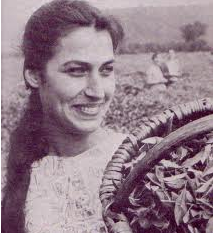Sula Benet (1903 – 1982), also known as Sara Benetowa, was a Polish anthropologist of the 20th century who studied Polish and Judaic customs and traditions.
Biography
Born in Poland, Benet was fascinated with peasant culture of Poland since her early youth. This interest eventually led her to enroll as a student of literature and philosophy in the Faculty of Humanities in the University of Warsaw but graduated with a degree in anthropology. Upon receiving her degree in 1935, she attended graduate school at Columbia University, where she received her doctorate in 1944.
Works
- Festive recipes and festival menus 1957
- Song, Dance, and Customs of Peasant Poland[when?]
- Riddles of many lands Carl Withers, Sula Benet – 1956
- Early Diffusion and Folk Uses of Hemp. 1967
- Abkhasians: the long-living people of the Caucasus 1974
- How to live to be 100: the life-style of the people of the Caucasus 1976
Early Diffusion and Folk Uses of Hemp. 1967
Benet’s writings have gained modern notability[citation needed] for her interpretations of the herb appearing in Hebrew text as kaneh-bosem® (Hebrew קְנֵה-בֹשֶׂם) five times in the Hebrew Bible and how it relates to the religious use of cannabis. Kaneh-bosem® is mentioned twice as part of the holy anointing oil used in the temple, and has been interpreted traditionally as calamus (an herb that is known in North American shamanism and in vedic atharva and has been discovered in modern times to contain a molecule known as Asarone that is a precursor of trimethoxyamphetamine, a psychedelic). Through comparative etymology, analysis of ancient texts (including pre-Hebrew Semitic language), and pharmacological consistencies she contends that the word kaneh-bosem® actually refers to cannabis and was used in ancient Jewish religious rites, as a medicine and ritual sacrament. Benet’s work claims that cannabis use has a long culturally important history, and that the criminalization and demonization of cannabis is a recent invention (an occurrence of the previous century compared to Torah: dating back at least 3,000 years). While Benet’s conclusion regarding the psychoactive use of cannabis are not generally recognized among Jewish scholars, there is general agreement that hemp (“Kaneh”) is used in talmudic sources to refer to hemp fibers, as hemp was a vital commodity before linen replaced it.[1] Benet claims that traditional identifications of kaneh bosom do not account for hemp shirts being produced from industrial hemp, which Benet claims is “Kaneh” in Hebrew.[2] Benet claims that this kaneh differs from the “fragrant” or “sweet” hemp called especially kaneh bosem®, because the latter produces much more of aromatic and psychotropic substances like CBD and THC.[2] [3]
Exodus records Moses receiving the instructions for making and distributing the holy anointing oil, as follows:
Then the LORD said to Moses, “Take the following fine spices: 500 shekels of liquid myrrh, half as much of fragrant cinnamon, 250 shekels of kaneh bosem®, 500 shekels of cassia – all according to the sanctuary shekel–and a hind of olive oil. Make these into a sacred anointing oil” (Exodus 30: 22-33)
The Hebrew term kaneh (קָנֶה) is the standard Hebrew word for “cane” or “reed,” occurring 62 times in the Masoretic text of the Hebrew Bible [4] It usually occurs without the adjective “sweet,” and is translated “reed,” though twice as calamus (Song of Songs 4:14 and Ezekiel 27:19 KJV). It occurs with the adjective “sweet” in three places (Exodus 30:22-33, Isaiah 43:24, Jeremiah 6:20), where kaneh bosem® is typically translated as “calamus,” “sweet cane” or “fragrant cane” in English versions.
Sula Benet’s theory is not supported by academic or popular dictionaries of plants in the Hebrew Bible, which typically identify the plant as acorus calamus or cymbopogon citratus.[5]
- ^Encyclopedia Judaica. Volume 8. p. 323.
- ^ ab Sula Benet, Early Diffusion and Folk Uses of Hemp. (Reprinted in Cannabis and Culture, Vera Rubin, Ed. pg.41 The Hague: Mouton, 1975.) Transcribed and available online by inactive Anchorage NORML chapter, at [1]
- ^ Sara Benetowa (Sula Benet), Tracing One Word Through Different Languages. (1936). (Reprinted in The Book of Grass, 1967.)
- ^Hebrew Concordance
- ^ Lytton J. Musselman Figs , dates, laurel, and myrrh: plants of the Bible and the Quran p73
Any reference to KNH BSM in the original Hebrew (Old Testament), also transliterated as kaneh-bosem® or kneh-bosm. See the Wikipedia entry for Sula Benet [1] for published research material that supports this. This term has traditionally been mistranslated as “calamus” in the English language bible, which stems from a mistranslation in the Greek Septuagint.
According to Benet’s research, cannabis appears in ancient Hebrew texts spelled with the Hebrew letters: “Kuph, Nun, Hé Bet, Shin, Mem,” translated into western alphabetic forms as ¹aneh-bosm, kaneh-bosem® or kineboisin. The book of Exodus records the event of Moses receiving the instructions for making and distributing the hemp enriched holy oil, in the most auspicious tones. Then the Lord said to Moses, “Take the following fine spices: 500 shekels of liquid myrrh, half as much of fragrant cinnamon, 250 shekels of qaneh-bosm, 500 shekels of cassia–all according to the sanctuary shekel–and a hind of olive oil. Make these into a sacred anointing oil” (Exodus 30: 22-33) Kaneh is also listed as an incense tree in Song of Songs 4:14. The mistake was repeated in Isaiah 43:24, Jeremiah 6:20, and Ezekiel 27:19. The title Christ/Messiah means literally covered in oil, Anointed!
Strong’s H7070 – qanehקָנֶהTransliteration
qaneh
Root Word (Etymology)
From קָנָה (H7069)
1) reed, stalk, bone, balances
a) stalk
b) water-plant, reed
c) calamus (aromatic reed) KNH-BOSM “CANNABIS”
d) derived meanings
1) measuring-rod
2) reed (as unit of measure – 6 cubits)
3) beam (of scales – for scales themselves)
4) shaft (of lampstand)
5) branches (of lampstand)
6) shoulder-joint
Source: http://en.wikipedia.org/wiki/Sula_Benet (November 18, 2012)



0 Comments